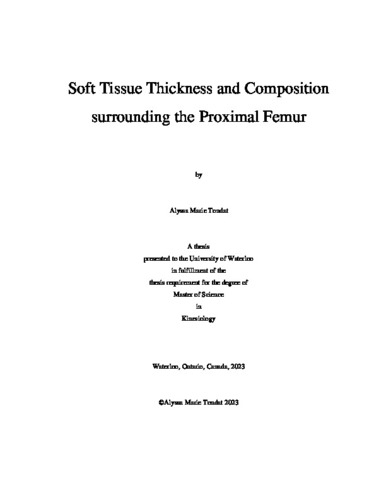| dc.description.abstract | Introduction: In Canada, approximately 30 000 hip fractures occur each year. Hip fractures are associated with significant morbidity, mortality, and quality of life changes. Trochanteric soft tissues have been shown to influence hip fracture risk by absorbing and dissipating energy during sideways falls onto the hip. However, previous research on the relationship between soft tissues and hip fracture has only considered the bulk thickness of the tissues without consideration of the differing contributions of muscle and subcutaneous adipose tissue to total thickness. In addition, despite evidence that the principle impact sites are distal to the greater trochanter (GT), the overwhelming focus has been on the soft tissues directly overlying the GT. Towards improved understanding of impact dynamics (and hip fracture risk), greater knowledge of soft tissue composition and spatial distribution surrounding the proximal femur is necessary.
Objectives and Hypotheses: The first objective is to assess the reliability of ultrasound methods to characterize soft tissue thickness and composition from multiple locations around the lateral proximal femur. The second objective is to provide insights into soft tissue thickness and composition from multiple locations around the lateral proximal femur. It is hypothesized that: 1) intra-rater reliability will be good to excellent (ICC > 0.75) for all soft tissue thickness measurements; 2) intra-rater reliability will differ between measurement locations, with reliability being lower for measurements on the anterolateral and posterolateral femur compared to the lateral femur; 3) there will be a main effect of sex on all soft tissue thickness measurements; 4) there will be a main effect of measurement location on all soft tissue thickness measurements.
Methods: 25 healthy young adults (12 males, 13 females) aged 18 – 35 years old with self-reported BMI ≤ 24.9 kg/m2 were recruited. B-mode ultrasound (GE LOGIQ E10 ultrasound machine with a L2-9VN-D probe) was used to take measurements of total soft tissue thickness, muscle thickness, and subcutaneous adipose tissue thickness on participant’s right hip and femur at 6 cm intervals throughout a 3 x 4 grid centered over the GT. To simulate a lateral fall, participants lay on their right side with their hips and knees straight on a specially designed table with a cut-out to allow for ultrasound imaging of the side of the femur that would impact the ground. Three ultrasound images were taken at each measurement location. Initial analysis was conducted on the 12 separate locations. Following this, thickness measurements from P1 – P4 were averaged together, L1 – L4 were averaged together, and A1 – A4 were averaged together to form posterolateral, lateral, and anterolateral groups. Two-way mixed effects absolute agreement intraclass correlation models (ICC 3,1) and 95% confidence intervals were used to assess intra-rater reliability across the 12 locations and three tissue types. A two-way mixed model ANOVA with sex as a between groups factor and measurement location (12 locations) as a within groups factor was used to assess differences in soft tissue thickness. A follow up two-way mixed model ANOVA with sex as a between groups factor and measurement location (3 locations) was then conducted to examine differences in soft tissue thickness over areas of the femur that are more representative of fall direction and orientation.
Results: ICCs were good to excellent (ICC > 0.75) for all tissue types and locations, except for muscle thickness and total thickness at A1 and P1. ICCs for muscle thickness were 0.486 at A1 and 0.593 at P1. ICCs for total thickness were 0.56 at A1 and 0.583 at P1. Intra-rater reliability was significantly lower at these locations for these tissues than other locations based on overlap between confidence intervals. There were significant main effects of sex and location across the 12 individual measurement locations for all tissue types (all p < 0.05). When grouping the locations together, there was an ordinal interaction between sex and measurement location for total soft tissue thickness (F = 4.229, p = 0.021) and significant main effects of sex and measurement location for all three tissue types (all p < 0.05). Males have significantly more muscle, more total soft tissues, and less adipose than females. Muscle thickness was largest over the anterolateral femur and smallest over the lateral femur, with significant differences between all three locations (all p < 0.05). Adipose thickness was largest over the posterolateral femur and smallest over the anterolateral femur, with significant differences between all three locations (all p < 0.05). Total soft tissues were significantly lower over the lateral femur compared to the posterolateral and anterolateral femur (p < 0.001), with no significant difference in thickness between the posterolateral and anterolateral femur (p = 1.0).
Discussion and Conclusion: Results highlight that this ultrasound protocol can be used to reliably measure tissue-specific thicknesses over the proximal femur, except for muscle and total thickness at A1 and P1 locations. The results also show that tissue-specific thicknesses vary across locations over the proximal femur, and with sex. Accordingly, it is important to consider the soft tissues surrounding the GT, the differing contributions of muscle and adipose tissues to total soft tissue thickness, and sex when developing both models of hip fracture risk (from an epidemiological perspective) and mechanical models of hip fracture (from a biomechanical tissue loading perspective). | en |

